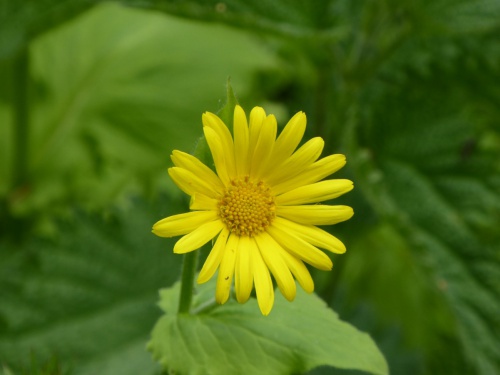Leopard's-bane - Doronicum pardalianches
D. pardalianches is a tuberous perennial spreading by underground runners. Loosely-branched clusters of light-yellow flowers are carried on upright stems, to 90 cm tall, above mid-green basal leaves to 12 cm long.
Other species and hybrids are grown in gardens and may naturalise in woodlands and shady places, including Doronicum plantagineum and Doronicum 'Harpur Crewe'.
Identification depends on the shape of the basal leaf, and details of the petioles. D pardalianches has cordate, rounded or truncate basal leaves, and basal leaf petioles with many long patent hairs; there are usually 3-8 flowerheads per stem.
A photograph of the whole plant, showing basal leaves at flower heads. This species cannot be verified from a photograph of the flower alone.
Grown as a cultivated plant and occasionally escaping and persisting for a time in the wild in woodland, streamsides and roadside verges.
Flowers from mid spring to early summer.
Tuberous perennial.
Well recorded in the north and west of Britain, and also in parts of East Anglia.
Scarce as a wild plant in Leicestershire and Rutland. In the 1979 Flora survey of Leicestershire it was found in 8 of the 617 tetrads.
Leicestershire & Rutland Map
Enter a town or village to see local records
MAP KEY:
Yellow squares = NBN records (all known data)
Coloured circles = NatureSpot records: 2020+ | 2015-2019 | pre-2015
UK Map
Species profile
- Common names
- Leopard's-bane
- Species group:
- Wildflowers
- Kingdom:
- Plantae
- Order:
- Asterales
- Family:
- Asteraceae
- Records on NatureSpot:
- 2
- First record:
- 30/04/2017 (McLoughlin, Margaret)
- Last record:
- 18/05/2017 (Nicholls, David)
Total records by month
% of records within its species group
10km squares with records
The latest images and records displayed below include those awaiting verification checks so we cannot guarantee that every identification is correct. Once accepted, the record displays a green tick.
In the Latest Records section, click on the header to sort A-Z, and again to sort Z-A. Use the header boxes to filter the list.




